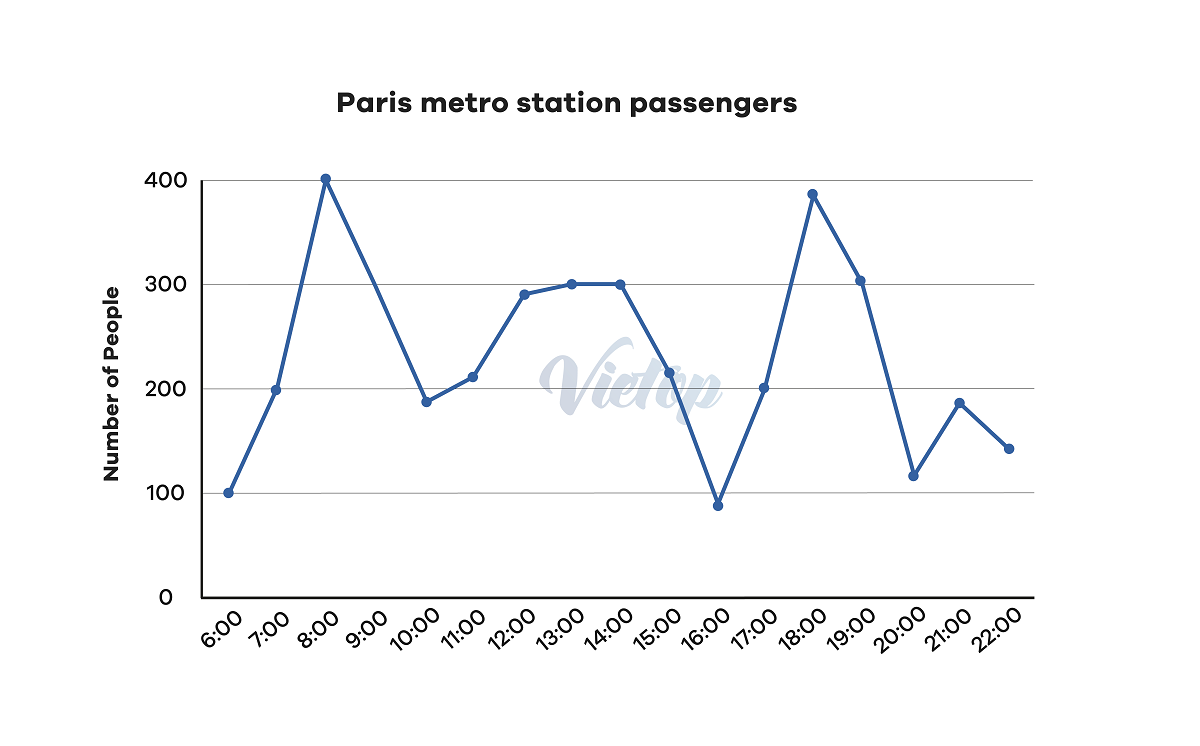Vietop gửi bạn bài Writing samples: Public Transport bên dưới nhé! Các bạn theo dõi và ôn luyện IELTS Writing thật tốt nhé!
IELTS Writing Task 1
| Task 1: The line graph shows Paris Metro station passengers |

Xem thêm: Trọn bộ đề IELTS Writing task 1 và IELTS Writing Task 2
Sample
The given line graph provides data on how many travelers use the Paris metro station at different times throughout a day.
Overall, it is clear that the number of underground users traveling from and to this place fluctuates wildly, with its peak recording at 8:00 and 18:00.
6:00 and 16:00 are when the passenger figures stand at lows of roughly 100. However, these numbers similarly quadruple after two-hour surges, making 8:00 and 18:00 the busiest hours in the day. The station then becomes less and less crowded as it comes to 10:00 and 20:00, the data for which are a little under 200 and 100 travellers, respectively.
Regarding the remaining surveyed times, there is a 50% increase in the number of metro passengers between 10:00 and 12:00. Two hours from noon shows a rare stability in the figure, which subsequently plunges to a trough at 16:00. From 20:00 to 22:00, the statistics continued to be volatile, ranging from approximately 100 to 180 people.
Vocab
- Fluctuate wildly (v): dao động dữ dội
- Quadruple (v): tăng 4 lần
- Plunge to a trough of (v): giảm mạnh tới đáy
- Volatile (adj): dao động
Phân tích
– Số liệu trong các khung giờ dao động rất nhiều.
– Có sự tương đồng về xu hướng tăng, giảm và đạt đỉnh của số liệu trong 2 khung giờ 6:00-10:00 và 16:00-20:00.
Tham khảo:
- Cách viết IELTS Writing Task 1 từ A – Z cho người mới bắt đầu
- Tổng hợp Vocabulary in IELTS Writing Task 1

Nhận tư vấn miễn phí khóa học hè
IELTS Writing Task 2
| Task 2: One way to solve the problem of congestion in cities is to build sky trains which run overhead rather than on or under the ground. What are the advantages and disadvantages of using this solution to solve congestion? |
Sample
Rapid transits have long proven a practical approach to traffic congestion, and, among the various available systems, many urban planners prefer sky rails to the ground-bound versions or metros. Although trains that are operated on elevated platforms offer some apparent pros, their cons should not be overlooked.
A comparison between underground and elevated railways shows that the latter are cheaper to erect and maintain in the long run. Their building is also less time-consuming and causes less disruption to transport and business activity on the streets. While tunneling requires vast sections of land to be excavated, overhead construction sites do not interrupt what happens on the ground as much. However, it is indisputable that sky trains, along with their tracks, distort urban architecture, making areas regarded as concrete jungles even stuffier and consequently not ideal for working and living.
When weighed against surface trains, sky alternatives are more advantageous in terms of space. Instead of area being allocated to train stations and railway lines, urban land could be better utilised by expanding existing lanes and introducing new bus-and-cycle-dedicated ones. This indeed prevents traffic from grinding to a halt during rush hour and considerably reduces commuting times due to high-speed travel. Dealing with emergencies yet raises particular concerns when elevated trains are in use. Should there be accidents or natural disasters, immediate evacuation and repairs may be quite challenging.
To conclude, projects of elevated tracks aiming at easing traffic volume should only be passed with full awareness of their potential financial and spatial benefits, compared to their safety matters and influences on urban settings.
Vocab
- rapid transit (n): hệ thống giao thông công cộng nhanh
- urban planner (n): nhà quy hoạch đô thị
- sky rail / elevated railway (n): đường sắt trên không
- excavate (v): đào bới
- distort (v): làm biến dạng
- concrete jungle (n): khu rừng bê tông (tả sự ngột ngạt của thành phố)
- grind to a halt (v): từ từ dừng lại
- evacuation (n): sự sơ tán
Tham khảo:
Chủ đề Đô thị (Cities) – IELTS Writing Task 2
Cách luyện IELTS Writing Task 2 ăn trọn điểm trong vòng 1 tháng
Phân tích
So sánh đường sắt ngầm và đường sắt trên cao:
– Đường sắt trên cao rẻ hơn và tốn ít thời gian hơn để xây dựng, và ít gây gián đoạn hoạt động trên đường phố.
– Tàu điện trên cao làm thay đổi kiến trúc đô thị.
So sánh đường sắt trên cao và đường sắt trên mặt đất:
– Tiết kiệm diện tích dành để mở rộng các cơ sở hạ tầng khác.
– Gây khó khăn cho việc đối phó với các trường hợp khẩn cấp.
Xem thêm: Khóa học IELTS và luyện thi IELTS cấp tốc được nhiều bạn tại TPHCM theo học nhất – Cùng tìm hiểu ngay nhé
Hy vọng phần chia sẻ về Writing samples: Public Transport đã giúp bạn thu thập thêm nhiều từ vựng, cấu trúc ngữ pháp và ý để phân tích chủ đề này tốt hơn khi luyện thi IELTS. Chúc bạn đạt điểm cao trong kỳ thi IELTS.
Tham khảo:

![[ACE THE TEST] Giải đề IELTS Writing ngày 20/07/2024 3 [ACE THE TEST] Giải đề IELTS Writing ngày 20/07/2024](https://www.ieltsvietop.vn/wp-content/uploads/2024/07/giai-de-ielts-writing-ngay-20-07-2024.jpg)
![[ACE THE TEST] Giải đề IELTS Writing ngày 11/07/2024 4 giai de ielts writing ngay 11 07 2024](https://www.ieltsvietop.vn/wp-content/uploads/2024/07/giai-de-ielts-writing-ngay-11-07-2024.jpg)
![[ACE THE TEST] Giải đề IELTS Writing ngày 06/07/2024 5 giai de ielts writing ngay 06 07 2024](https://www.ieltsvietop.vn/wp-content/uploads/2024/07/giai-de-ielts-writing-ngay-06-07-2024.jpg)
![[ACE THE TEST] Giải đề IELTS Writing ngày 22/06/2024 6 [ACE THE TEST] Giải đề IELTS Writing ngày 22/06/2024](https://www.ieltsvietop.vn/wp-content/uploads/2024/06/giai-de-ielts-writing-ngay-22-06-2024.jpg)
![[ACE THE TEST] Giải đề IELTS Writing ngày 15/06/2024 7 [ACE THE TEST] Giải đề IELTS Writing ngày 15/06/2024](https://www.ieltsvietop.vn/wp-content/uploads/2024/06/giai-de-ielts-writing-ngay-15-06-2024.jpg)
![[ACE THE TEST] Giải đề IELTS Writing ngày 08/06/2024 8 [ACE THE TEST] Giải đề IELTS Writing ngày 08/06/2024](https://www.ieltsvietop.vn/wp-content/uploads/2024/06/giai-de-ielts-writing-ngay-08-06-2024.jpg)
![[ACE THE TEST] Giải đề IELTS Writing ngày 01/06/2024 9 [ACE THE TEST] Giải đề IELTS Writing ngày 01/06/2024](https://www.ieltsvietop.vn/wp-content/uploads/2024/06/giai-de-ielts-writing-ngay-01-06-2024.jpg)
![[ACE THE TEST] Giải đề IELTS Writing ngày 25/05/2024 10 [ACE THE TEST] Giải đề IELTS Writing ngày 25/05/2024](https://www.ieltsvietop.vn/wp-content/uploads/2024/05/giai-de-ielts-writing-ngay-25-05-2024.jpg)


